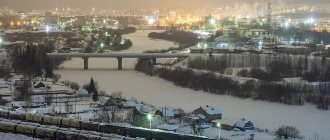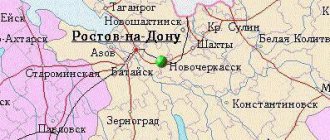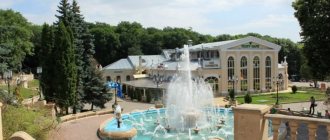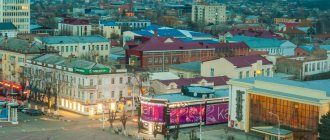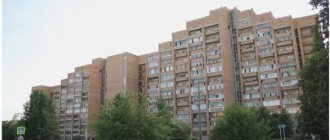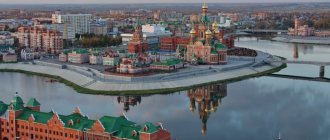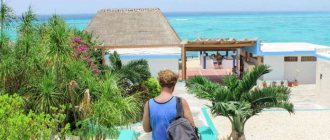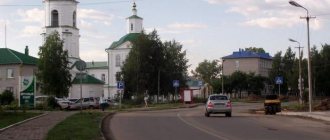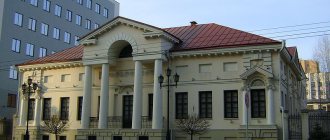- September 2, 2019
- Directions
- Andrey Ruzaev
Not everyone knows where Ukhta is. And it is located in the very center of the Komi Republic and is a relatively small town. These regions themselves are rich in forests and have a beautiful but harsh nature. The city itself is equated to the regions of the Far North. It grew out of the notorious camps of the Soviet past, then developed thanks to oil production. And now the second most important city in the region is Ukhta. It’s easy to guess which one comes first - Syktyvkar (administrative center).
The beginning of the city's history
The area around the Ukhta River, where the city will be in the future, began to be developed by people mainly thanks to oil. The settlement itself would then be named after her. This small river is a tributary of the Izhma, which in turn flows into the Pechora. It carries its waters north, to the ocean. Here, where the Ukhta (river) is located, they began to extract oil for the first time in Russia. This currently valuable mineral was found back in the 15th century, but they didn’t know how to use it then. Oil was used only for medical purposes and for lubricating mechanisms.
Chibyu River and the birth of the city
Speaking about the Ukhta River, one cannot help but talk about one of its tributaries - the Chibyu River . The history of the city began with it, when on August 21, 1929 the Ukhta expedition of the OGPU Chibyu flows into the Ukhta River and the construction of a village began, called Chibyu . Until the 60s of the last century, the river was really fast, high-water and clean; in some places the depth reached three meters. Forests grew on both banks, red and black currants grew in the lowlands, and fish were found. The trees did not allow it to dry out. But the city was being built and advancing on Chibyu . In the first half of the 70s, from the village of Zabolotny , all the way to the Ukhta , a canal was dug - a new artificial channel of the Chibyu River . The canal was built almost three meters below the old bed, and the height difference is visible in the area of the bridge to Shudayag .
The site for construction was, of course, freed up, the groundwater level in a vast area was significantly lowered, but the city lost a beautiful river, beaches and forest. The deadliest blow to Chibyushka came in 1975. Old Ukhta residents, of course, remember that on Zabolotny , where there is now a memorial sign to the victims of political repression, there was a zone. And across the road, on the site of the Lukoilov gas station , there are two large camp pigsties. When the pigsties were demolished, all the manure from the manure storage facility was simply shoveled into the river, killing all the fish. Unfortunately, today Chibyu is more like a large drainage ditch; in some places the river does not freeze in winter, as warm water flows from the sewage outlets. City residents also contribute by littering the banks and riverbed with garbage. I would like to note that Chibyushka was not left to the mercy of fate. Gazprom Transgaz Ukhta LLC , the river bank in the area of the Gazovikov embankment has been remarkably landscaped, and from the city the river received a new bridge in the KiO park and landscaping of the pond.
Oil production
Oil exploration was first organized in 1745 by the ore explorer Pryadunov. We can say that the city of Ukhta is where oil is produced in Komi today. But it was not always so. At first it was drawn from wells and springs. The distillation was carried out in Moscow, 3.6 tons of “flammable water” were brought to the laboratory. Not much by modern standards, but this is just the beginning. Even then, this oil was appreciated; it was studied in Hamburg and recognized as “no worse than Italian.” Oil was extracted very slowly by dredging from the surface of the water and from coastal pits.
For this purpose, specially on the river, at the place where the oil spring is located, a wooden frame was erected and a cutwater was made (a stone dam to fence off the frame from the river). A special container with a hole at the bottom was placed inside it; oil flowed through it on its own, rising to the surface of the water. From there they scooped it up with birch bark ladles.
At the moment, this technology seems ineffective, but at that time there was no alternative. Soon misfortunes began: first, during a river flood, the production well was destroyed, then Pryadunov was sent to prison due to non-payment of tithes. Ukhta oil was remembered only in 1868, and production resumed thanks to the merchant Sidorov. He allocated funds for drilling a well.
Then this was not the only production area; there were already wells in Galicia and Baku. Under Sidorov's leadership, about 33 tons of oil were produced. Local black gold was examined by Mendeleev himself and highly appreciated its qualities.
First settlement
For the first time, the village of Chibyu appeared on the site where the city of Ukhta is located, which happened after the revolution, in 1929. This was the first full-fledged settlement. Since 1933, Chibyu became the center of Ukhtpechlag (one of the centers of the Gulag). An unfavorable and difficult time for people, but it gave development to the village. In addition, thanks to its location in the very center of the Komi Republic, Chibyu grew and developed. Soon a new name appeared - Ukhta. At one time they even wanted to make this urban-type settlement the administrative center of the region, but all plans were confused by the war. At the same time, Ukhta received city status.
Churches and temples of Ukhta
Church of the New Martyrs and Confessors of Russia who shone forth in the land of Komi
Address: st. Zeryunova, 5A Phone: 8 (2167) 6-40-01, 8 (2167) 2-44-74 Website: https://sobory.ru/article/?object=16389
Included in the complex of the Church of the Intercession of the Blessed Virgin Mary. Local residents say that the church was built on the site of the first burials, which is considered holy.
Inside there is a myrrh-streaming icon of the New Martyrs, created by the best icon painters.
Church of St. Stephen the Great
Address: st. Oktyabrskaya, 8 Phone: , 8 (247) 4-09-78 Website: https://komihram.narod.ru/pr1/index.html
The church is located in the building of the city's former cultural center. The temple consists of a library, baptism and Sunday school.
Inside are icons painted by a local school teacher.
Church of the Intercession of the Blessed Virgin Mary
Address: Zeryunova Avenue Telephone: 8 (2147) 6-40-01 Website: https://komihram.narod.ru/pr6/index.html
The temple was built thanks to the efforts of local residents. It is a two-story building, where the abbot’s office, library and school are located on the first floor, and the prayer house is located on the second floor.
Inside is an iconostasis made by prisoners.
Included in the complex of the Cathedral of New Martyrs and Confessors of Russia.
Camp times
The infamous Ukhtpechlag is associated with Ukhta. The Ukhta-Pechora camp included a huge territory of 1.5 million km2 with its center in Ukhta. What a vast area, and yet everything is dedicated to prison! It also included the upper and middle reaches of the Vychegda and the Pechora basin. The camps also captured the Timan Ridge. If you look on old maps of Russia to find out what region Ukhta is in, then on them it was listed as the Autonomous Region of Komi. Today it is not part of the region, but of another subject of the Federation - the Komi Republic.
The Ukhtpechlag administration was located in Chibyu (present-day Ukhta). Since 1931 it has been one of the Gulag prison centers. More and more prisoners were brought here along the highway.
The barracks were overcrowded; according to data, there were about two thousand people here. In 1929, a mechanical repair plant opened here. It was thanks to the repressed that the village began its intensive development, and the development of the north took place. The prisoners had a lot of hard and life-threatening work; not everyone lived to see their release. They mined coal, obtained radium from local radioactive waters in laboratories, and significantly increased the volume of oil produced. The world's only oil mine was built in the upper reaches of the Yarega River, where they began to extract heavy oil. A vocational school was even organized, where the necessary specialists were trained from prisoners.
Museum of Ukhta State Technical University
We didn’t get to the Ukhta Museum of Local Lore, but while walking around the city, we learned about the existence of another museum. Since 2009, the local technical university has opened its own historical exhibition, which, according to the students we met, is much more interesting than the city one.
The director of the university museum, Evgenia Anatolyevna Zelenskaya, was incredibly surprised by the delegation suddenly appearing on her doorstep in bright orange jackets, but still gave us a fascinating tour.
Back in the 16th century, fur hunters talked about Finno-Ugric tribes who lived on the banks of the Ukhta River and used the oil that rose from the river bottom for medicinal purposes. The first reliable written mention of Ukhta oil is found in the book of the Dutch traveler Nicholas Witsen “Northern and Eastern Tartaria,” published in 1692:
The Ukhta River is a tributary of the Pechora. On this river, a mile and a half from the portage, there is a shallow place where an oily substance is released, which floats on the water and is black oil.
In 1724, the first samples from the Ukhtinsky Oil Spring were delivered to St. Petersburg. Industrial development of the field began a quarter of a century later by merchant and ore explorer Fyodor Pryadunov, who in 1748 delivered the first convoy with 40 pounds of “Russian oil” to Moscow. The commercial plan failed, the fishery went bankrupt, and Fyodor Pryadunov himself ended his life in debt.
Until the end of the 19th century, oil was used mainly in medicine. A radical change occurred after the invention of kerosene lamps. Then the demand for oil increased sharply, and in 1868, in the same place where Fyodor Pryadunov’s field was once located, Russian entrepreneur Mikhail Sidorov began drilling the first oil well in the Russian Empire. In subsequent years, oil production in Ukhta actively developed, and even the revolution did not greatly affect this process.
The industrialization of the young Soviet state, announced in 1925, required centralized mining in various inaccessible places. There were no people willing to voluntarily go to work in the dense forests and swamps, so the government, in the spirit of the times, decided to “organize new forced labor camps in order to colonize these areas and exploit their natural resources through the use of prison labor.”
The issue with the labor force was resolved, and in 1929, at the confluence of the Chibyu River with Ukhta, the construction of one of the first Soviet camp centers began with the forces of the first detachment, which included political and criminal prisoners, former kulaks, civilians and security guards. It was named after the river - Chibyu.
In 1931, Ukhtpechlag (in full - Ukhta-Pechora forced labor camp) was formed on its basis. All lands from Mezen to the Urals and from Vychegda to the coast of the Arctic Ocean came under his control, in total more than a million square kilometers. Yakov Moroz, who had only two years of education behind him, was appointed head of the camp, but remained in his post until the reorganization of Ukhtpechlag in 1938. He didn’t need cars or horses (give more prisoners, and we’ll build a road even to the North Pole!), and he easily sent prisoners to the winter taiga without tents (they’ll warm themselves by the fire!) and without boilers for cooking food (they’ll do without hot!)…
By 1938, Ukhtpechlag had become completely ungovernable. Then three new formations were withdrawn from its composition: Ustvymlag with a center in Ust-Vym, engaged in timber extraction, Vorkutlag with a center in Vorkuta, engaged in coal mining, and Sevzheldorlag with a center in Knyazhpogost (now the city of Yemva), which was entrusted with the responsibility construction of the Pechora railway. Ukhtpechlag itself was transformed into Ukhtizhemlag, which concentrated on oil production. By the height of the Great Patriotic War, Ukhta oil and Vorkuta coal gained access to the main industrial centers of the country.
In 1939, Chibya was renamed Ukhta. In 1943, the village received city status.
Yakov Moroz was shot in 1940 for counter-revolutionary activities.
All exhibits presented in the museum are authentic. The portrait of Stalin, for example, was painted by one of the prisoners.
Conditions of detention in Ukhtpechlag were very cruel. I had to work 12-15 hours without days off. Many prisoners had neither warm clothes nor shoes, and the tents in which they lived did not have stoves. There was not enough food, and sometimes there were even cases of cannibalism.
In 1936, political prisoners of Ukhtpechlag organized the first strike in the history of the Gulag. They were waiting for an amnesty, or at least an improvement in living conditions, but in response a decision came from Moscow on mass executions.
Dry lines from the resolutions:
CHARGED with the fact that while serving his sentence in Ukht.Pech.ITL, together with a group of prisoners, he was engaged in systematic crime. [counter-revolutionary] agitation. He praised the tsarist system, discredited the bodies of Soviet power, and expressed sympathy for the fascists from the Troitsk-Zinoviev gang. SHOOT.
CHARGED that while serving his sentence in Ukht.Pech.ITL he carried out systematic crime. [counter-revolutionary] agitation, praising the tsarist system. He spread slander against Soviet power and expressed sympathy for the enemies of the people from the Troitsk-Zinoviev gang. SHOOT.
In total, several thousand people were shot; for the rest, the camp regime was tightened: production standards were increased by 25-30% and “columns” (a paramilitary form of labor organization) were introduced.
By the end of the 1930s, in Komi, through forced labor camps, 100% of oil and coal were extracted, 100% of electricity was generated, and 30% of timber was harvested.
Ukhta, along with all residential buildings, public buildings and industries, was built down to the last brick by prisoners. Remember, in the first part of my story I showed you a three-story Stalinist house with a beautiful arch? There, several years ago, during renovations in one of the apartments, under the floor, the following board was found (the original spelling was preserved):
June 5, 1951 Builders of the 14th OLP [individual camp point] carpenters With terms of 12 years without parole [loss of rights] 8 years without parole [defeat of rights] Dear Owners, Long live Nozdarov and for us
Here's another one:
Sharov worked here. He wishes the owners of this room a good life for many years. Of course, maybe someone will be offended by our work, but he will be wrong, because we did not come to build ships of our own free will. But we, even the unapproachables, do not look at us [inaudible], because we, too, were guardians [of the interests] of our homeland, our beloved homeland.
At the top it is written:
It has a lifespan of 7 years, 3 years. [defeat] in rights
Another message was found under the wallpaper in another house:
Builder Locust Petr Petrovich we are tried by decree for a period of 10 years the beginning of 1949 the end of 1959 we are tried for the construction of communism my crime is a penny prisoner the crime has not been proven by anyone just impudently judged required free labor born 1923 age 28 years torn from the family family went to beg
Scary and sad words. It is possible that these old boards and scraps of paper with the souls of prisoners poured onto them are all that remains of their lives...
Postcard.
Many of the prisoners of Ukhtpechlag and Ukhtizhemlag were rehabilitated after Stalin's death in 1953-1954. However, the operation of forced labor camps in Komi continued until the early 1960s.
According to declassified documents, at least one million one hundred thousand people passed through the millstones of Ukhtpechlag and Ukhtizhemlag alone. And these are only those whose cases are preserved in the archives.
One of the museum’s halls is dedicated to a unique method of oil production – the mine method.
This is how oil is produced in Yarega, a small village located 20 kilometers from Ukhta and formally being one of its administrative units.
I’ll tell you about the Yaregskoye oil field a little later, but for now just look at the next photo. This is oil-saturated sandstone.
Backstage (photo source: ; author: Evgeniy Grokh).
Ukhta was built at an accelerated pace. In 1929, on the site of the future city there was only a stunted swampy forest and a couple of rickety wooden buildings. By 1933, the mining technical school was commissioned, and by 1934, the theater. By the beginning of the Great Patriotic War, Ukhta was already a full-fledged city - with its own stadium, park, canteen-restaurant, department store and hotel.
In the university hall there is a model of the city of that time. Almost all the buildings then were wooden, and most of them have not survived to this day.
In the background with white columns is a school.
A large dark building with lit windows is a mountain technical school. The main administration of Ukhtpechlag was also located here.
The white building is the Ukhta dining room and restaurant.
Club-theater. Graduates of the best theater universities - actors, musicians and dancers from among the prisoners - performed on its stage. In 1948, the club-theater was dismantled, and in its place a stone cultural center appeared, which today has been turned into a temple (I talked about it a little higher).
Dynamo Stadium.
Kashketi executions
In 1936, protests began among political prisoners. They demanded their separate maintenance from criminals, improved living conditions and normal medical care. In 1937, 6,890 prisoners were already serving their sentences in the camp.
Since 1938, mass executions began under the leadership of Lieutenant Kashketin. At that time, 86 prisoners were executed in the village of Chibyu. And in the area of the Ukhtarka River, 1,779 people were shot in a short time. In order to destroy such a number of people in a short time, they resorted to a trick. They organized a “transition” from one camp to another, lined up the prisoners in a column and led them through the tundra, where an ambush and a prepared grave awaited them. All prisoners were shot with a machine gun. These events would later be called the “Kashketi executions.” Soon after this, the village left the Gulag, and power again transferred to the Komi administration.
Architecture
A typical northern Russian city with a mining industry is Ukhta. You can see right away where the city-forming enterprises are located.
If you look at the city from an elevated position, you can see an industrial zone in one part of the view. Here is the Ukhta oil refinery, which was launched during the Gulag period (in 1934).
In another part you can see the residential buildings of the city; they, like steps, go from bottom to top. This is due to the fact that the city was built on the Timan Ridge. The buildings are dominated by high-rise buildings from the 60s to 80s. The massive Oil and Gas Research Institute is also visible. There is also the old town, the embankment of the Ukhta River, the victory memorial and the Lukoil office.
A little more about the Ukhta River
But let's return to the Ukhta River . Despite its small width and smooth flow, the river periodically presented the city with surprises, especially during the spring flood.
In the 40-60s of the last century the Workers' Village , Zarechnaya , Pochtovaya , Vokzalnaya , Yuzhnaya and the floodplain of the river, where the Dynamo , always found themselves in the flood zone. For example, on May 19, 1946, a water rise of 252 cm was recorded.
In 1962, the new Neftyanik Sports Palace . They built it in the floodplain of the Ukhta River on the site of the old stadium, and it also suffered from high water.
The very next year, a dam was filled with rubble along the river, protecting it and the stadium from flooding.
Well, the largest rise in water on the river was in 1992 - 678 centimeters. That, for now, seems to be all I wanted to tell you about the Ukhta River . The story may not be very complete, but don’t judge too harshly.
Old city
You can see interesting architecture in the old town. Ancient buildings were once created in the USSR according to the designs of talented architects P.K. Murzin and Zhizhimontov. One of them was a prisoner. Although they were both from Moscow, the Leningrad style can be seen in the old city.
The old town, built in the 50s, sets Ukhta apart from other cities with the oil industry. The streets are wide, the buildings are all different, but in a common style. On the houses themselves there are a lot of small and large decorative elements from the times of the USSR. It feels like a short but interesting story.
There is a local history museum, and next to it is a monument in the form of a stone, stern and gloomy, dedicated to the innocent victims of repression. There are also technical schools in the city: Mining and Railway transport. The same wooden barracks and buildings from which the village of Chibyu, which later became Ukhta, began, have been preserved.
In Ukhta you can see a memorial and chapel dedicated to the memory of those who died during the fire in the shopping center. 25 people were burned alive, mostly employees of the shopping center. According to the official version - arson, two teenagers were sentenced to life imprisonment.
The Temple of Stephen of Perm makes an interesting impression. Looking at it, it is difficult to believe in the church purpose of this building. In appearance, it is an ordinary cultural center, although very beautiful. And indeed, it used to house the oil workers' recreation center. Only in 1994 it was converted into a temple. They say that the architect Zhizhimontov, who designed this building, was a believer and always dreamed of building a temple. Thus, his dream came true, but not immediately, but after about half a century. However, dreams come true, no matter what.
